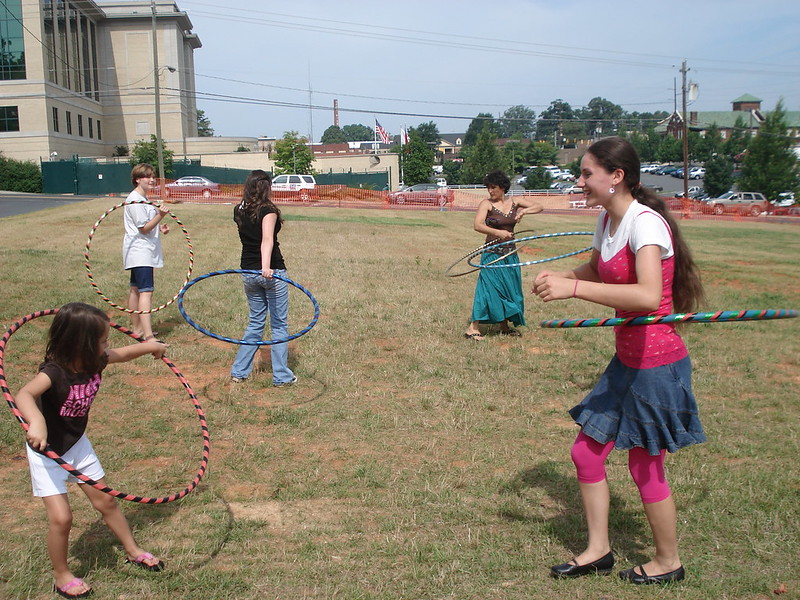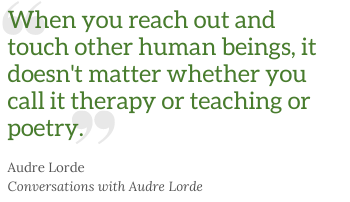Taking Care of Self, Staff, and Community
Brenda Hough is a librarian, writer, and trainer with 25 years of professional experience working in and supporting libraries by providing training and consulting services. Betha Gutsche is a WebJunction Program Manager at OCLC.
Self-care has long been recommended and recognized as important. It’s easy to find articles about the value of self-care: eat healthy, get plenty of sleep, exercise regularly. It can get exhausting just reading about all the things we should be doing to feel better. How can we help self-care feel less like a burden and more like genuine kindness and nurturing? What if we could tap into our larger community to bolster our own well-being while increasing social cohesion for all? There is a continuum – from self-care to staff (workplace) care to community care – that gets stronger as it fans out from solo activity to broader inclusive action and impact.
Starting with Self
Taking care of one’s self is vital. Testimonials abound about the rejuvenating effects of adopting healthier life habits. Eating well boosts energy levels. Stretching and breathing deep in a yoga practice releases physical tensions. Walking among trees or along a wave-swept beach is calming. These activities all help to relieve stress and heal the mind and heart.
The weakness of self-care is that it places the burden of healing on the individual. It suggests that it is each person’s responsibility to take action to feel better. Especially in COVID times, it can exacerbate feelings of isolation and disconnection. And not everyone has the resources or energy to pursue self-care. It’s a Catch-22 situation; often when we need self-care the most, we lack the resources to pursue it (time, money, energy, etc.). Overall, we are social beings and most of us need social connection for deeper sustenance. If the fabric of society has holes, it is social connection that can help with the mending.
The Workplace: Steppingstone to Community Care
Self-care is not isolated to private moments at home. Well-being is something that needs to be considered in all elements of life, including at work. There is a well-established correlation between a healthy workplace culture and a productive, motivated workforce1. Given that we spend so much of our time at work (whether in-person, virtual, or hybrid), the workplace is a focal community of foremost importance. It is a huge boost to well-being when library staff feel that their institution cares about their health and wellness and provides them with appropriate resources. Of course, this is in the hands of administration and supervisors and is far from being assured. Fortunately, many directors are recognizing the power of prioritizing staff wellness, a reality brought into sharper focus by the compounded external stressors of the last 18 months.
The prioritization of staff well-being is not only reflected in individual level wellness support (vacation days, health insurance, etc.), but also in the creation of a culture that is healthy. Transparency builds trust and communication is ongoing. Making time for discussing important issues at staff meetings can contribute to a culture of support and belonging, for example.
There is also evidence that healthy workplace culture translates to enthusiasm and creativity for supporting community health through programming. Steven Potter, Director of Libraries at Mid-Continent Public Library (MO), believes firmly in this correlation. In his presentation for Wellness Works! The Importance of a Healthy Workplace for Healthy and Happy Library Staff (Potter’s section begins at 21 minutes), he emphasizes and reiterates that you can’t separate the two factors of staff and patron well-being. “Mid-Continent Public Library has found that when we consider healthy options for the public, the staff benefits, and healthy staff options create a better experience for the public.”
This observation is affirmed by Noah Lenstra, Assistant Professor of Library and Information Science, University of North Carolina Greensboro. For several years, Lenstra has studied how libraries support healthy living in their communities (See Healthy Living at the Library: Programs for All Ages). “One recurring theme in my research is how when library staff feel like their institution cares for them and provides them with resources and support for self care, those staff are in turn excited to ‘pass it on’ by sharing said resources with the patrons and communities they serve.”
A Bridge from Self-care to Community Care

Social connections are vitally important – our species is hard-wired this way. Numerous studies2 link physical and emotional well-being to the strength of one’s social connectedness. Caring for one’s community is integral to strengthening social bonds, feeling that we are part of a meaningful whole. Putting energy into caring for others taps into a sense of purpose and offers intrinsic, intangible rewards. Purpose increases fulfillment. This is the bridge that extends self-care into community care.
Many people are drawn to the library profession for just that reason – a desire to contribute to the community good. However, in times of high stress, that commitment bumps up against the dangers of vocational awe3, compassion fatigue, and burnout. Pandemic closures and constraints have required so much rethinking of services and inventing new ways to connect with patrons safely. Layer that on top of personal stresses and it may feel like too great a burden to do anything beyond caring for one’s self.
A key element to balancing these tensions is to identify the self-care practices that have the potential to move from an isolated individual experience to something that radiates benefits to others, too. When staff can create programs for the public that arise out of their personal passions, it can feed into their self-care rather than draining it. Conducting a staff survey to discover skills and interests not included in their job descriptions may uncover talents that have the potential to generate programs that are restorative for all involved.
Programs that bridge from self-care to community care will vary widely across libraries, reflecting the unique interests of staff and needs of the community. The following examples are a small sampling of the opportunities:
- Library staff who restore and energize themselves through a yoga practice might welcome the chance to share their passion with a wider circle; they might offer classes or issue movement challenges and have community members record and share their actions.
- Those who enjoy making and crafting might get inspired by Gina Seymour’s compassionate making ideas to lead programs where community members (children, youth, adults or intergenerational) get together to craft things that address local hardships.
- Those who love to cook might find greater satisfaction in teaching others or just cooking in a collaborative kitchen setting; expand the social bonding by sharing the output at a community meal. WebJunction’s Social Library has a Cooking Edition full of ideas for the virtual versions of connecting through cooking.
- Getting outdoors is good for everyone’s health. Pandemic restrictions have prompted more creative ways to get outside and interact with community members. And it’s not just for warm summer weather –find ideas for programs that can go a long way to relieving the winter doldrums.
- StoryWalks® have become popular in many libraries, creating an outdoor literary experience. Julie Pasieka, Youth Services Coordinator for Galway Public Library (NY), heightened the basic format and put a community care spin on it by building her StoryWalk® along the wooded trails behind the library. It gets people of any age outside and exercising. “I had used the trails myself and always thought they were so beautiful. I thought having a StoryWalk® back there would be a great opportunity for the community.”
Care for BIPOC Communities
The longstanding systemic racism in our society has been painfully spotlighted during the last 18-months with the deaths of George Floyd, Breonna Taylor, Ahmaud Arbery, and many others. In addition, COVID-19 has disproportionately claimed the lives of racial minority communities. For Black, Indigenous, and people of color (BIPOC) library staff and community members, social connection and community care are crucial for a sense of belonging and collective well-being.
- BIPOC library staff may find strength in forming affinity groups with community members, especially when they may have few colleagues who share their life experiences. Janet Damon, Library Services Specialist at Denver Public Schools, shares her powerful approach to centering staff of color and providing space for community care in her Affinity Groups and Libraries webinar.
- For any community care program, BIPOC library staff may want to focus their interests and talents on specific communities within their service population. For example, a yoga class series that is specifically for women of color can connect them with healthy breathing and stretching activity while connecting with each other. A walking club could be organized within a BIPOC community location that is familiar and comfortable to participants, where they have some ownership of the space and can enjoy the physical activity and social interaction with each other.
- Gardening is another passion that is often shared between library staff and community members. Collaborating with a community of color to introduce a garden into their environment combines food justice and sovereignty with fostering cultural relevance. The BLOOM Giving Garden project initiated by Seattle Public Library began during the pandemic as an effort to reconnect BIPOC youth with their cultures through growing food. It is still flourishing in its second year.
- Specific to library professionals, We Here “seeks to provide a safe and supportive community for Black and Indigenous folks, and People of Color (BIPOC) in library and information science (LIS) professions and educational programs, and to recognize, discuss, and intervene in systemic social issues that have plagued these professions both currently and historically.”
Individual staff don’t have to go it alone. However passionate they are, generating a new program likely adds to their workload. To counterbalance the burden of responsibility on staff, look for partners and collaborators to distribute the effort. Think beyond institutional partners. Encouraging community members to contribute ideas and lead programs augments the social solidarity and feelings of belonging. Co-creation of programs centers the intended participants and empowers them to share their skill sets and lived experience. “Community-care, at its core, is a shared responsibility to attend to the needs of the people within a group, centered in trust and reciprocity.”4
Additional Resources on WebJunction
- A Holistic Approach to Library Staff Health and Wellness, by Bobbi Newman
- Prioritizing and Promoting Self-Care to Avoid Burnout, a webinar presented by Nicole T. Bryan
Footnotes
[1] Proof That Positive Work Cultures Are More Productive, Harvard Business Review, 2015. https://hbr.org/2015/12/proof-that-positive-work-cultures-are-more-productive
[2] Connectedness & Health: The Science of Social Connection, The Center for Compassion and Altruism Research and Education. http://ccare.stanford.edu/uncategorized/connectedness-health-the-science-of-social-connection-infographic/
[3] Vocational Awe and Librarianship: The Lies We Tell Ourselves, In the Library with the Lead Pipe, 2018. https://www.inthelibrarywiththeleadpipe.org/2018/vocational-awe/
[4] Energy Exchange: The Urgency to Move from Self-Care to Community-Care in Student Affairs, The Vermont Connection, 2018. https://scholarworks.uvm.edu/cgi/viewcontent.cgi?article=1306&context=tvc

